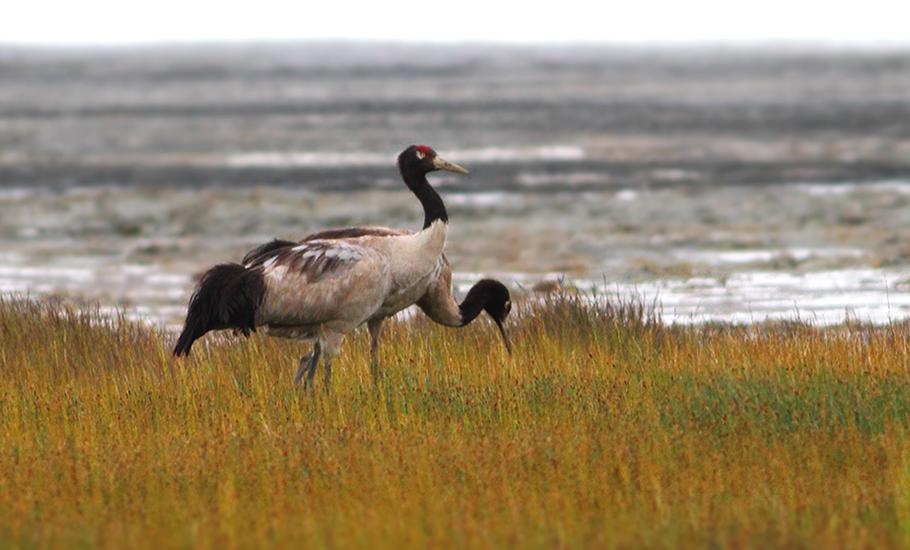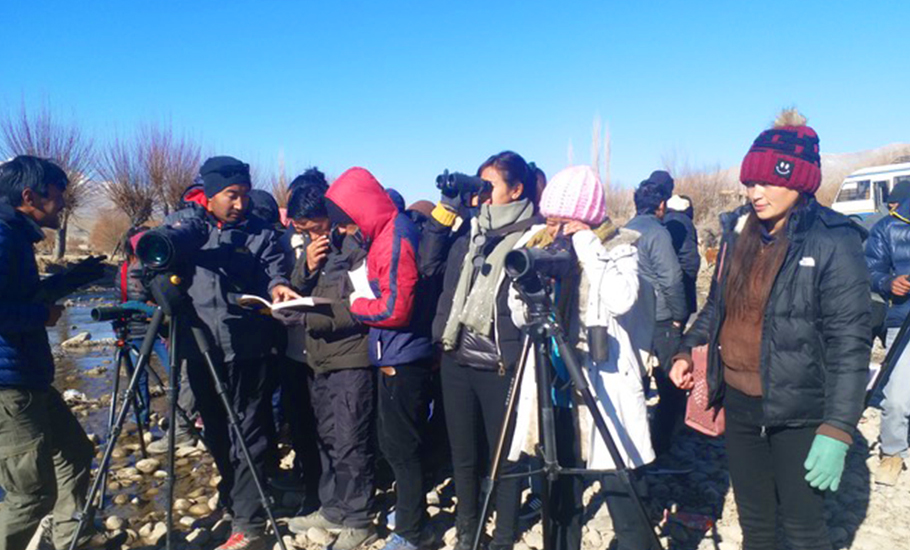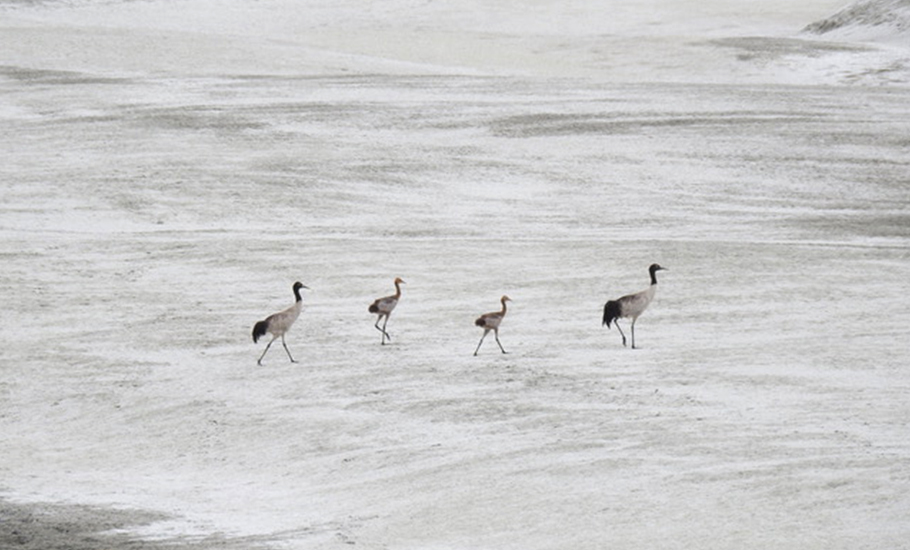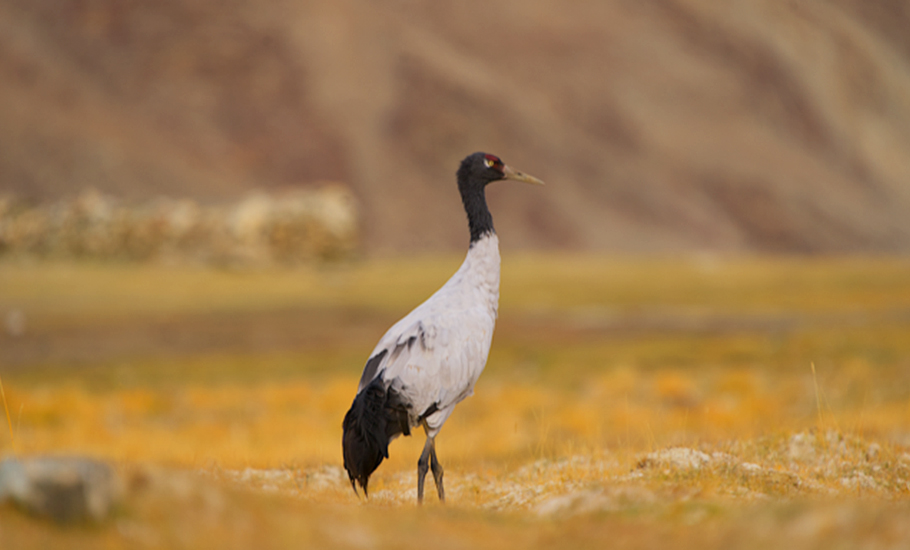
- Home
- News
- Analysis
- States
- Perspective
- Videos
- Education
- Entertainment
- Elections
- World Cup 2023
- Features
- Health
- Business
- Series
- Economy Series
- Earth Day
- Kashmir’s Frozen Turbulence
- India@75
- The legend of Ramjanmabhoomi
- Liberalisation@30
- How to tame a dragon
- Celebrating biodiversity
- Farm Matters
- 50 days of solitude
- Bringing Migrants Home
- Budget 2020
- Jharkhand Votes
- The Federal Investigates
- The Federal Impact
- Vanishing Sand
- Gandhi @ 150
- Andhra Today
- Field report
- Operation Gulmarg
- Pandemic @1 Mn in India
- The Federal Year-End
- The Zero Year
- Premium
- Science
- Brand studio
- Home
- NewsNews
- Analysis
- StatesStates
- PerspectivePerspective
- VideosVideos
- Entertainment
- ElectionsElections
- Sports
- Loading...
Sports - Features
- BusinessBusiness
- Premium
- Loading...
Premium

Tourist rush in Ladakh is tightening the noose around the black-necked crane

For years, Tresing Dorjey’s (name changed) life has depended on nature lovers and travel enthusiasts deciding to traverse the difficult terrain of Ladakh for the thrill, adventure and cultural experience it offers. The pandemic thus served as a huge jolt to Tresing as the travel industry took one of the worst hits from Covid. But this summer, after two years of Covid curbs, as people began...
For years, Tresing Dorjey’s (name changed) life has depended on nature lovers and travel enthusiasts deciding to traverse the difficult terrain of Ladakh for the thrill, adventure and cultural experience it offers.
The pandemic thus served as a huge jolt to Tresing as the travel industry took one of the worst hits from Covid. But this summer, after two years of Covid curbs, as people began to flock in unprecedented numbers to the Union Territory, Tresing, a small-time tourist guide from Thukje village of Tso Kar area of eastern Ladakh, also known as Changthang, found himself deeply concerned and worried.
Many tourists visit Changthang’s wetlands to spend hours marvelling at birds and the beauty around. One such person this summer chose Tresing to show him the place. Together the duo sat looking at the black-necked crane. Taking the tourist for a birdwatcher, Tresing had no way to know what was to happen next.
“I thought he [tourist] was a birdwatcher,” Tresing recalls. “Both of us were calmly watching a black-necked crane at Khardung La. This is the place where you can sit and soak in the beauty of what nature has to offer for hours. I thought this person with me was doing the same for he dropped no hints of anything otherwise. Until he suddenly pulled out a gun from his backpack lying close by and, before I knew it, shot down a crane.”
“It was the sight of absolute horror. The bird died squealing in pain. Its body lay motionaless, soaked in blood splattered around it,” Tresing tells The Federal.
The killing not just shook Tresing but his entire community that reveres the bird and considers them their pride. “This bird is our pride and identity,” the tourist guide says. “But this unregulated tourism has endangered its habitat.”
The black-necked crane was the state bird of the erstwhile state of Jammu and Kashmir. After the 2019 bifurcation of the region into the UTs of Jammu and Kashmir and Ladakh, the latter chose the species as its state bird in 2021 when it also declared snow leopard as its state animal. The black-necked crane is found only in Changthang’s high-altitude wetlands and marshes and is listed as ‘Near Threatened’ on the International Union for Conservation of Nature red list.

The birds arrive in the region as early as March for breeding and leave by October-end or early-November. But experts have raised concerns over how the loss of habitat could lead to the extinction of the birds from this region.
Tresing is worried that the increasing footfall of tourists and the reckless construction being carried out to accommodate the tourists and needs of the locals could lead to the disappearance of black-necked cranes from Changthang.
This year, the number of tourists in Ladakh broke all previous records. According to official data, as many as 2.5 lakh tourists visited the capital Leh in just two months – June and July. That’s eight times more visitors than Leh city’s total population of around 30,870 (as per 2011 census).
Tresing’s life itself has undergone changes due to the exploitation of nature. Before working as a tourist guide, he would shepherd Pashmina goats in Changthang. But as the grazing lands became scarcer due to increased troop build-up on the ground near the Line of Actual Control, his tribe started switching to other modes of livelihood.
“By 2016, I was facing an increased paucity of grazing grounds for the goats. Around the same time some tourists visiting Tso Kar asked to guide them. As I began to earn money out of working as a guide on and off, I switched to working as a guide completely,” he said.
“I moved to Leh and worked in a hotel for a year. After that I became a fulltime tourist guide.”
Since that 2016 shift, Tresing has guided hundreds of tourists in his hometown. But even as his own earnings have risen, he finds the existence of the black-necked crane increasingly threatened.
The bird is not just ecologically, but also culturally important to the people of Ladakh. Black-necked cranes are short-term migrants in Ladakh, yet their elegance, tall and stately as they are, has inspired myths, folk dances, art, research and wildlife expeditions. Revered in Tibetan Buddhism, the bird appears frequently in Ladakh’s thangka paintings and monastery murals.
Pairs are said to mate for life, and so people have turned the bird into representatives of true love. Its graceful mating dance is the basis for one of Ladakh’s most popular folk dances, the chartses. And it is probably due to this reason that the bird’s Ladakhi name — cha thung-thung — sounds musical too. “The black-necked cranes mate for life and are seen as a symbol of true love, that’s why people in Ladakh treat sighting the bird as a mark of good luck,” Tresing says.
But Ladakh is literally running out of ‘good luck’ due to human activities and climate change which is having an adverse impact on the wetlands.
A major threat to the successful breeding of black-necked crane is the damage to the eggs and chicks, caused by feral dogs.
“In India, we have around 20 breeding pairs of cranes,” says Pankaj, senior conservation scientist. “And the main problem with these is that whenever they lay their eggs on the ground inside wetlands, the dogs eat them.”

These dogs are owned both by armed forces as well as by the local nomads. The dog population increases due to leftover food from army and tourists, Pankaj shared.
Another threat to the bird is the loss of habitat.
The World Wildlife Fund (WWF) identifies unregulated development work, irresponsible tourist activities, vehicular traffic and climate change in eastern Ladakh as reasons that have adversely altered the wetlands, considered home to the black-necked crane.
Currently, WWF is focusing on three major wetlands in Changthang — Tso Moriri, Tsokar, and Pangong Tso. “The three face a serious threat from unmanaged tourism,” the WWF says in its research findings. “Their fragile ecosystems have been suddenly exposed to pressure from the outside world, with consequent impacts on local resource use.”
Tresing Namgail, director of Snow Leopard Conservancy India, told The Federal that the general public appears least bothered about the ecological change in eastern Ladakh despite the vocal campaign run by the region’s youth against the ravages of tourism.
“Declaring black-necked crane as the state bird of Ladakh somehow helped in its preservation and conservation efforts,” Namgail says. “But the larger administrative apathy towards its conversation can’t be neglected.”
At present, he said, in Hanley, we have around two to three breeding pairs of black-necked cranes and many non-breeding ones are visiting.
“The problem is that a lot of tourists come to see the world’s highest motorable road near the LAC in Changthang and disrupt the ecosystem of these birds,” Namgail says.
“In fact, lot of bikers are riding everywhere without any concern for environment these days. These bikers drive everywhere disturbing wild animals and the sensitive top soil.
Some 5 inches of the soil takes 100 years for formation, but it gets destroyed within seconds.”
Besides these ecologically destructive drives, Namgail said, a lack of proper garbage management system in Changthang is also risking the bird’s survival. Tourists throw things around with little regard for cleanliness or the ecological sensitivity of the place.
“The waste goes into the soil and contaminates the groundwater, stream and lake,” he explains. “It affects the whole system at different levels. There are no advisory sign boards for tourists which only escalates this waste problem.”
Earlier, the “unregulated” tourist footfall created by the Bollywood blockbuster 3 Idiots (2009) had irreversibly harmed the banks of Pangong Tso. The unabated littering eventually prompted the civil society to enforce some checks and balances.
And now, Namgail said, the wetlands of Changthang are facing a similar fate due to unregulated tourism in Ladakh. “All this is coming at the cost of our state bird.”
A group of conservationists, who visited Ladakh in August to review the condition of the cranes, were left worried.
“We returned disappointed,” says a scientist from Kashmir University who was part of the inspection team on the condition of anonymity. “The chicks were quite weak and weren’t in a position to fly back during the onset of winters.”
“We need to understand that this species is very sensitive,” he said. “If they notice any disturbance in their habitat, they won’t come in that area again.”
Tso Moriri, which used to be one of the most importing breeding wetlands for these cranes, is hardly seeing any birds following the fencing of the area. “Any small change in the ecological character of the region has a direct impact on the species,” the scientist says.

“And the human intervention though various development works, like laying the highest motorable road near the LAC, has added to destruction of the bird’s habitat. These activities in a fragile ecosystem will have a drastic change in the migration pattern and breeding grounds of the crane.”
In the face of this existential crisis, Wildlife Conservation and Birds Club of Ladakh (WCBCL), a local voluntary organisation working for the wildlife preservation had proposed a nest adoption project to the UT government.
“The idea was to gather first-hand statistical data regarding the impact of climate change on the extremely vigilant and shy birds during their breeding season,” Lobzang Visuddha, chairman WCBCL, tells The Federal. “It would have reduced attacks on the nests by feral dogs and created awareness among local community regarding the protection of the cranes.”
In their defense, the officials say that they have increased the manpower and patrolling and monitor attacks on the chicks and eggs from dogs.
“We have a shortage of technical staff but we are working hard to make sure that whenever the birds are injured during poaching or accidents, we provide them the best care,” says Tashi Yakzi, councillor (Wildlife) Ladakh Autonomous Hill Development Council. “Since the last two years, we have seen poaching cases but the UT government took strict action against them,” Yakzi says.
The actions notwithstanding, Tresing fears Ladakh is not far from losing the black-necked crane forever even as it gains tourism revenue.
Talking of solutions, he says, “There should be designated places for tourists. A proper tourist itinerary should be made keeping the conservation of the black-necked crane in mind. We can’t go on promoting mindless tourism and end up losing our state symbol in return.”
“The bird means good luck for us. Its disappearance from the region may not bode well for us.”

